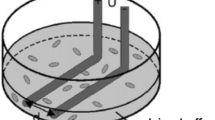Abstract
Purpose. DNA plasmids (pDNA) can be taken up by and expressed in striated muscle after direct intramuscular injection. We have developed interactive polymeric gene delivery systems that increase pDNA bioavailability to muscle cells by both protecting pDNA from nucleases and controlling the dispersion and retention of pDNA in muscle tissue.
Methods. A DNA plasmid, containing a CMV promoter and a β-galactosidase reporter gene (CMV-β-gal), was injected either in saline or formulated in polyvinyl pyrrolidone (PVP) and polyvinyl alcohol (PVA) solutions. Interactions between PVP and pDNA were assessed by dynamic dialysis, Isothermal Titration Calorimetry (ITC), and Fourier-Transformed Infra Red (FT-IR) spectroscopy. Formulations (50 µl) were injected into rat tibialis muscles after surgical exposure. Immuno-histochemistry for β-gal was used to visualize the sites of expression in muscle.
Results. β-gal expression using pDNA in saline reached a plateau while β-gal expression using PVP formulations increased linearly in the dose range studied (12.5–150 µg pDNA injected) and resulted in an increase in the number and distribution of cells expressing β-gal. The interaction between PVP and pDNA was found to be an endothermic process governed largely by hydrogen-bonding and results in protection of pDNA from extracellular nucleases.
Conclusions. Significant enhancement of gene expression using interactive polyvinyl-based delivery systems has been observed. The improved tissue dispersion and cellular uptake of pDNA using polyvinyl-based systems after direct injection into muscle is possibly due to osmotic effects.
Similar content being viewed by others
REFERENCES
J. A. Wolff, R. W. Malone, P. Williams, C. Wang, G. Acsadi, A. Jani, and P. L. Felgner. Direct gene transfer into mouse muscle in vivo. Science 247:1465–1468 (1990).
S. Jiao, P. Williams, R. K. Berg, B. A. Hodgeman, L. Liu, G. Repetto, and J. A. Wolff. Direct gene transfer into nonhuman primate myofibers in vivo. Hum. Gene Ther. 3:21–33 (1992).
M. Manthorpe, F. Cornefert-Jensen, J. Hartikka, J. Felgner, A. Rundell, M, Margalith, and V. Dwarki. Gene therapy by intramuscular injection of plasmid DNA: studies on Firely Luciferase gene expression in mice. Hum. Gene Ther. 4:419–431 (1993).
M. Y. Levy, K. B. Meyer, L. Barron, and F. C. Szoka. Mechanism of gene uptake and expression in adult mouse skeletal muscle. Pharm. Res. 11:317 (1994).
C. M. Gorman, L. F. Moffat, and B. H. Howard. Recombinant genomes which express chloramphenicol acetyltransferase in mammalian cells. Mol. Cell. Biol. 2:1044–1051 (1982).
V. Buhler. Kollidon: Polyvinylpyrrolidone for the pharmaceutical industry. BASF Aktiengesellschaft Feinchemie, Ludwigshafen, 1993.
W. R. Gombotz, S. C. Pankey, D. Phan, R. Drager, K. Donaldson, K. P. Antonsen, A. S. Hoffman, and H. V. Raff. The stabilization of human IgM monoclonal antibody with poly(vinylpyrrolidone). Pharm. Res. 11:624–632 (1994).
L. D. Murphy and S. B. Zimmerman. Macromolecular crowding effects on the interaction of DNA with Escherichia coli DNA-binding proteins: a model for bacterial nucleoid stabilization. Biochim. Biophys. Acta. 1219:277–84 (1994).
Y. Galaev, N. Garg, and B. Mattiasson. Interaction of Cibacron blue with polymers: implications for polymer-shielded dye-affinity chromatography of phosphofructokinase from baker's yeast. J. Chromatogr. A. 684:45–54 (1994).
I. Matsubara, Y. E. Goldman, and R. M. Simmons. Changes in the lateral filament spacing of skinned muscle fibres when cross-bridges attach. J. Mol. Biol. 173:15–33 (1984).
G. D. Rieser, R. A. Sabbadini, and P. J. Paolini. The effects of chemical cross-linking agents on calcium-induced structural changes in skinned muscle fibers. Origin within thick filaments detected by optical diffraction methods. Biochim. et Biophy. Acta. 707:178–189 (1982).
G. D. Lamb, D. G. Stephenson, and G. J. Stienen. Effects of osmolality and ionic strength on the mechanism of Ca2+ release in skinned muscle fibres of the toad. J. Physiol. Lond. 464:629–48 (1993).
K. Tyml. Heterogeneity of microvascular flow in rat skeletal muscle is reduced by contraction and by hemodilution. Int. J. Microcirc. Clin. Exp. 10:75–86 (1991).
M. Otagiri, T. Imai, H. Koinuma, and U. Matsumoto. Spectroscopic study of the interaction of coumarin anticoagulant drugs with polyvinylpyrrolidone. J. Pharm. Biomed. Anal. 7:929–35 (1989).
A. V. Kabanov and V. A. Kabanov. DNA complexes with polycations for the delivery of genetic material into cells. Bioconj. Chem. 6:7–20 (1995).
S. Keipert and R. Voigt. Interaction between macromolecular adjuvants and drugs. Improvement of the solubility characteristics of benzodiazepine derivatives with polyvinylpyrrolidone. Pharmazie 41:400–404 (1986).
Author information
Authors and Affiliations
Rights and permissions
About this article
Cite this article
Mumper, R.J., Duguid, J.G., Anwer, K. et al. Polyvinyl Derivatives as Novel Interactive Polymers for Controlled Gene Delivery to Muscle. Pharm Res 13, 701–709 (1996). https://doi.org/10.1023/A:1016039330870
Issue Date:
DOI: https://doi.org/10.1023/A:1016039330870




